

Wing and Flap FairingsI fit and drilled my wing
fairings while I had the wings on for their initial fit. I
had a little trouble figuring out what the plans meant by fitting
everything "flush" to the tanks, and had to work through a few other
small issues, but I'll show you here how I figured them all
out. I waited until the wings were on for the final time and
the flaps had been rigged before doing the flaps. I worked a
bit on getting the seam to disappear into the curve of the fuselage,
and I also had a few problems with edge distance and holes drilled
earlier. This all required some considered improvisation, but
everything worked out and I'm very pleased with the results.
I found that the tank bracket got in the way of the top of the F-872A fairing, and needed to be trimmed down. 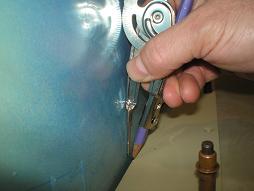 To
mark the 3/16” gap
along the fuselage, I used an old
carpenter's trick. I
set a compass so the
distance between the pencil and the point was 3/16”, then ran it along
the
fuselage with the point touching the fuselage and the pencil marking a
line on
the fairings.
How Did That Happen? 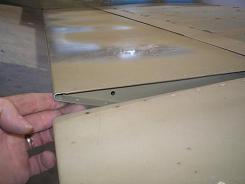 I
don’t know how it happened, but I messed up the flap
fairings. I had measured their location with the wings on,
and the flaps installed. Then I removed everything and
riveted the fairings in place. When I went back to finally
install the flaps, the fairings didn’t match up. First, I
needed to figure out where I went wrong. I
don’t know how it happened, but I messed up the flap
fairings. I had measured their location with the wings on,
and the flaps installed. Then I removed everything and
riveted the fairings in place. When I went back to finally
install the flaps, the fairings didn’t match up. First, I
needed to figure out where I went wrong.The worst case would be that I had messed up drilling the wings. I rechecked their angle of attack to ensure they were right on. The next worse case would be that I had mis-rigged the ailerons. This would be a simple fix, except for the wig tips. But they were rigged correctly. The only thing left is that I installed the flap fairings at the wrong place. So the answer was to move the fairings. Unfortunately, if I just lowered the fairings to match the top of the wing, then old holes would show. This was unacceptable, so I decided to make new fairings that were just a little larger than the originals. The lower skin of the flaps doesn’t quite lay flat on the bottom of the fuselage, they miss by a little less than ½ inch. So I decided that while I was at it, I would make the fairings match up to the bottom of the flaps. 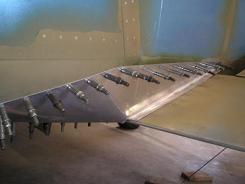 My
new
fairings are kind of “U” shaped.
They look a lot like the originals on the top and back side; they are
just a little larger to ensure they cover the holes. It is on
the bottom of the fuselage that they differ greatly. My new
fairings are about 3 inches wide on the bottom, giving me room to rivet
them to the belly on the inside, while the outside sits under the
bottom flap skin. My
new
fairings are kind of “U” shaped.
They look a lot like the originals on the top and back side; they are
just a little larger to ensure they cover the holes. It is on
the bottom of the fuselage that they differ greatly. My new
fairings are about 3 inches wide on the bottom, giving me room to rivet
them to the belly on the inside, while the outside sits under the
bottom flap skin.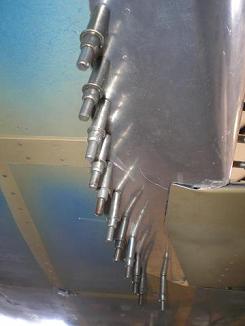 I
made the pattern by starting with the old fairings. I added
poster board strips to the top and back until I got the size I needed
to be able to use the holes across the top and cover the old holes in
the back. Then I added poster board to the bottom to get the
size to match to the belly and flap. Once my cardboard
creation fit the top and bottom of the flap, and covered the holes, I
flattened out the old fairing. This gave me a flat template
to cut a new piece of aluminum. I cut and bent the new
aluminum to fit the top and back just like the old fairing, and drilled
it in place. Then I spent a lot of time hand bending the
bottom until I got a good fit to the belly and flap. I
drilled the holes and then trimmed it to final size. I
made the pattern by starting with the old fairings. I added
poster board strips to the top and back until I got the size I needed
to be able to use the holes across the top and cover the old holes in
the back. Then I added poster board to the bottom to get the
size to match to the belly and flap. Once my cardboard
creation fit the top and bottom of the flap, and covered the holes, I
flattened out the old fairing. This gave me a flat template
to cut a new piece of aluminum. I cut and bent the new
aluminum to fit the top and back just like the old fairing, and drilled
it in place. Then I spent a lot of time hand bending the
bottom until I got a good fit to the belly and flap. I
drilled the holes and then trimmed it to final size.Return from Wing and Flap Fairings to Final Assembly Return from Wing and Flap Fairings to Kit Plane Advice Home |
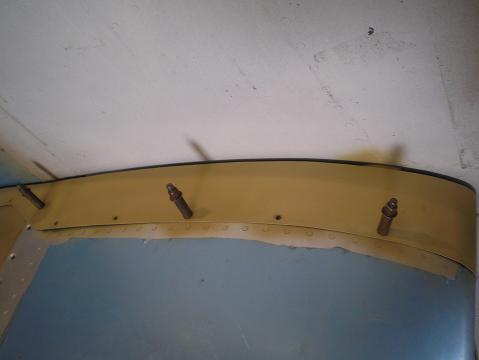
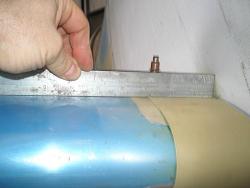 I
spent a lot of time
bending the F-872A forward wing root
fairing.
I
spent a lot of time
bending the F-872A forward wing root
fairing.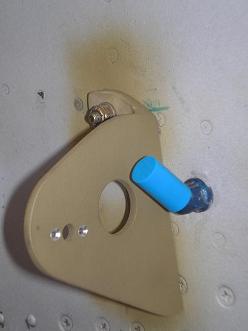 sit flat
on the wing and continue inboard without pitching up or down.
sit flat
on the wing and continue inboard without pitching up or down.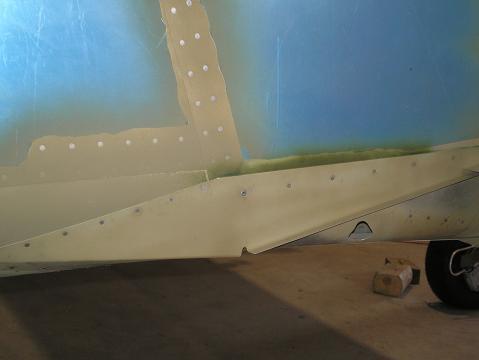
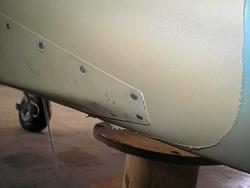 I
fit the fairing with
the flap in the full up
position.
I
fit the fairing with
the flap in the full up
position.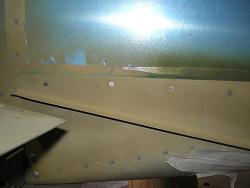 When
I went to back drill the holes for the top of the
fairing through the F823 skin and F-815B floor rib, some of the holes
would not
work.
When
I went to back drill the holes for the top of the
fairing through the F823 skin and F-815B floor rib, some of the holes
would not
work.